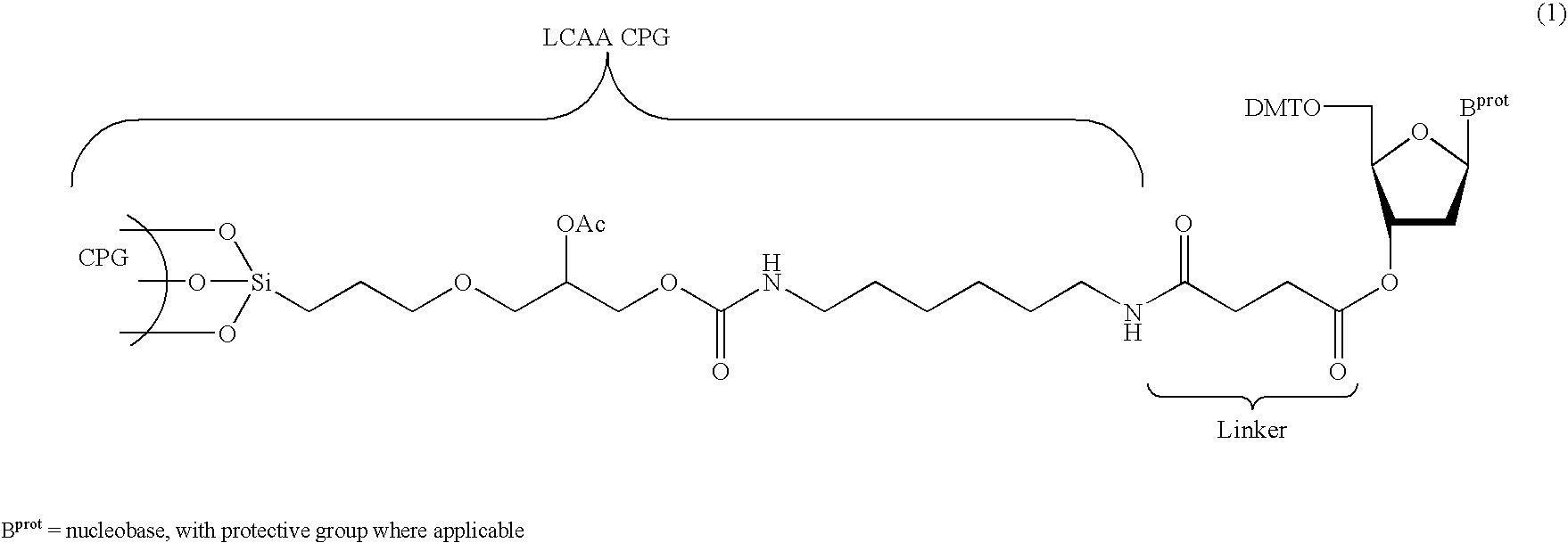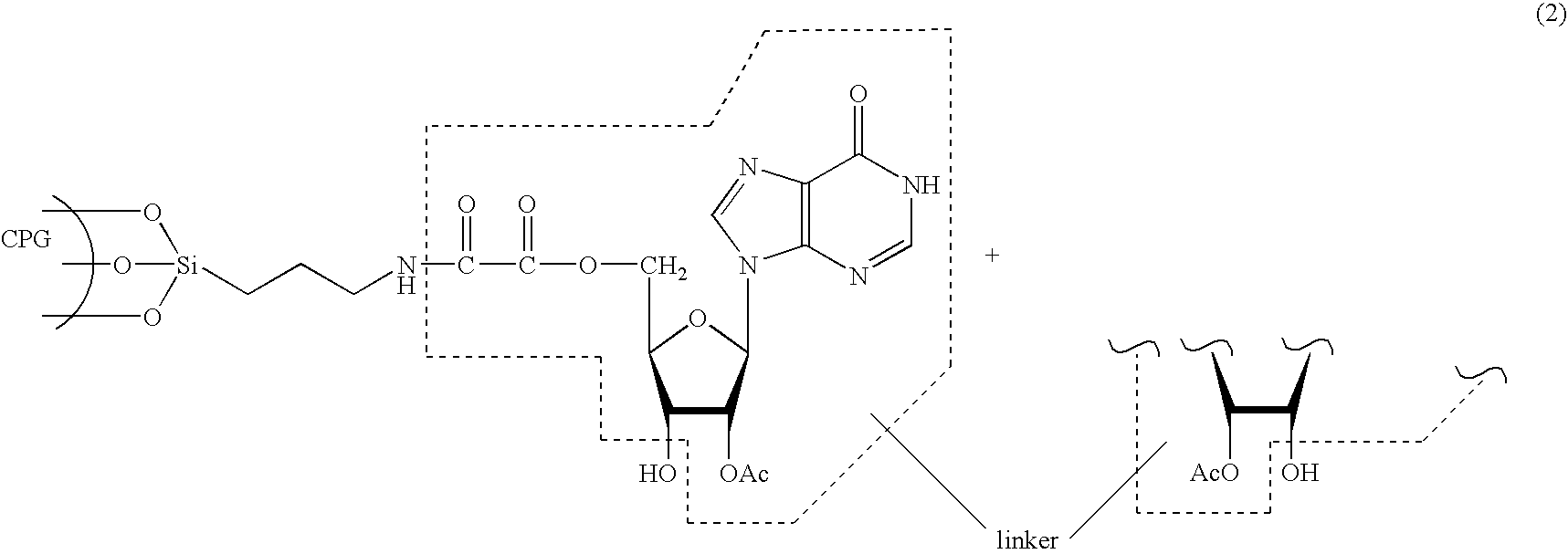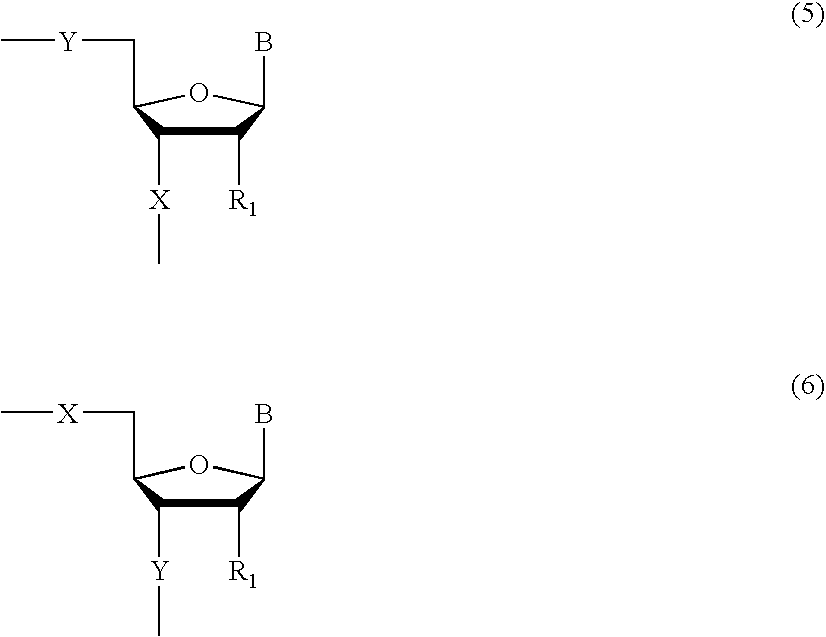Methods and compositions for the tandem synthesis of two or more oligonucleotides on the same solid support
a technology of oligonucleotide and solid support, which is applied in the field of nucleotide synthesis, can solve the problems of long reaction time required to cleave the products of the linker, not useful for some biochemical applications, and is usually not very efficient, and achieves the effects of simple, smooth and efficient, and increased ra
- Summary
- Abstract
- Description
- Claims
- Application Information
AI Technical Summary
Benefits of technology
Problems solved by technology
Method used
Image
Examples
example 1
Preparation of Universal Solid Support (8)
[0101] Dried long-chain-alkyl-amino (LCAA)-derivatized aminopropyl CPG (300 g, porosity 500 or 1000 Å, loading value for amine functions: 100 μmol / g, + / −20%) was suspended in 1000 mL oxalyl chloride at room temperature in a rotavap at high speed under reduced pressure for 20 minutes. The temperature was then raised to 100° C. and the excess oxalyl chloride was removed by distillation, requiring a period of about 3 hours. Following removal of the excess oxalyl chloride, a freshly prepared solution of O2′,O3′-methoxyethylidene inosine (62 mmol, 2 equiv.) in anhydrous pyridine (1200 mL) and N-methylimidazole (10%, v / v) was added to the activated CPG and reacted at room temperature with high speed rotation under reduced pressure for 20 minutes, such that evaporation occurred. Acetic anhydride (120 mL) was then added to the reaction mixture over a period of 5 minutes at room temperature with intense agitation to provide CPG preparation (8). Foll...
example 2
Preparation of the 2′ / 3′-DMT-protected Universal Solid Support (10)
[0103] The derivatized CPG (8), prepared as described in Example 1, was transferred to a glass-fritted funnel and washed once with a solution of TFA in 1,2-dichloroethane (1%, v / v), and successively with 1,2-dichloroethane and acetonitrile (3× each), to provide CPG preparation (9), which was dried in vacuo for 1 hour. To a portion of (9) with a total inosine loading of 34 μmol, was added a solution of dimethoxytrityl chloride (2.5 mmol, 74 eq.), DMAP (0.31 mmol) and triethylamine (2.92 mmol) in anhydrous pyridine (10 mL). The reaction mixture was stirred at room temperature for 2 hours. The resulting CPG was collected on a glass-fritted funnel, washed successively with pyridine (4×), acetonitrile (3×) and diethyl ether (1×), and finally dried in vacuo to afford the tritylated support (10).
[0104] For (10) a loading value of 53 μmol / g was measured by cleaving off the DMT moieties in a test sample (TFA (1%, v / v) in 1,...
example 3
Preparation of the 2′ / 3′-Fmoc-Protected Universal Solid Support (11)
[0105] To a portion of the derivatized CPG support (9) with a total inosine loading of 0.31 mmol, was added DMAP (1.08 mmol), 9-fluorenylmethyl chloroformate (Fmoc-Cl, 18.58 mmol) and anhydrous pyridine (110 mL). The reaction mixture was stirred at room temperature for 2 hours. The resulting CPG was collected on a glass-fritted funnel, washed successively with pyridine, methanol (2×) and acetonitrile (3×). In order to cap non-converted hydroxyl groups, the reaction product was then reacted with a mixture of equal volumes of N-methylimidazole in acetic anhydride (10%, v / v) and anhydrous pyridine on the fritted funnel. The product, compound (11), was then washed successively with pyridine (2×) and acetonitrile (3×) and dried in vacuo.
[0106] The loading value of CPG preparation (11) was determined to be 56 μmol / g by cleaving off the Fmoc groups in a test sample (piperidine (20%, v / v) in DMF, 15 minutes at room temper...
PUM
| Property | Measurement | Unit |
|---|---|---|
| porosity | aaaaa | aaaaa |
| temperature | aaaaa | aaaaa |
| v/v | aaaaa | aaaaa |
Abstract
Description
Claims
Application Information
 Login to View More
Login to View More - R&D
- Intellectual Property
- Life Sciences
- Materials
- Tech Scout
- Unparalleled Data Quality
- Higher Quality Content
- 60% Fewer Hallucinations
Browse by: Latest US Patents, China's latest patents, Technical Efficacy Thesaurus, Application Domain, Technology Topic, Popular Technical Reports.
© 2025 PatSnap. All rights reserved.Legal|Privacy policy|Modern Slavery Act Transparency Statement|Sitemap|About US| Contact US: help@patsnap.com



